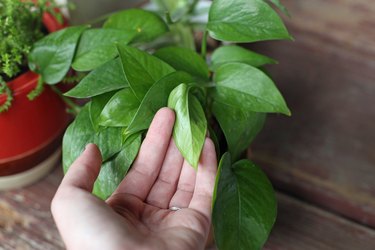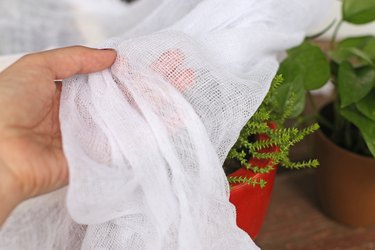
Leaf-footed bugs (Leptoglossus spp.) have long mouthparts they use to pierce and suck the sap from plant leaves, fruit and shoots. They receive their common name due to the flattening of their hind tibia resembling a leaf. Although the feeding activity rarely damages ornamental plants, they can cause discoloration, blemishes or pitting when they feed on ripening fruit. In most years, the damage is mostly cosmetic and should cause no concern for backyard gardeners. When a severe outbreak occurs, however, you might need to combine cultural and mechanical control methods to manage the pests without using any harsh chemicals.
Remove Them
Video of the Day

Inspect your plants daily during a leaf-footed bug outbreak, looking inside of fruit clusters or dense layers of leaves for hiding bugs. Handpick adult bugs and drop them into a container of soapy water. Wear gloves when dealing with these pests because they release an unpleasant odor when disturbed. Using a small handheld vac or shop vac helps reduce pest populations if you suck them off the plants every day or two. Vacuum or handpick in the early morning when the cool weather makes the pests sluggish and unlikely to fly off. Look for egg masses on the undersides of plant leaves. Scrape off any you find with a dull knife or your fingernails and destroy them, or pick the affected leaves from the plant and discard them in a covered trash can.
Video of the Day
Exclude Them

Covering garden plants with lightweight polyester or cheesecloth row covers can stop leaf-footed bugs from feeding on your crops. In the spring, the adult females lay strings of 10 to 50 eggs along leaf midribs or stems. You must drape row covers early enough in the growing season to prevent the egg-laying females from reaching the plants. If you wait too long to spread the row covers, you risk increasing pest populations by trapping the newly hatched leaf-footed bugs in with the food crops. Anchor the covers firmly with wood, rocks, soil or anchoring pins so the bugs don't find a way in. Remove the covers when plants start blooming so the pollinators can reach them and the plants don't get too hot.
Trap Them

Another natural way to control leaf-footed bugs is to plant sunflowers as a trap crop. The common sunflower (Helianthus annuus), an annual that grows across most of the U.S., is a very good trap plant option. As the name implies, sunflowers prefer fully sunny locations. Place plants in neutral to slightly alkaline soils and water them regularly for the best growth. Once your sunflowers start blooming, large numbers of leaf-footed bugs will swarm the flowers. Once the bugs arrive, start shaking the plants and step on the insects that fall. Placing a white-colored groundcover beneath the sunflower plants can help you spot the fallen pests more easily. Repeat this process at least once a week until you don't spot any more leaf-footed bugs.
Clean Up

Adult leaf-footed bugs overwinter in protected locations and emerge when the weather warms up in the spring. Some of their favorite overwintering spots include weedy areas, woodpiles, leaf piles and other garden debris. Removing weeds, fallen leaves and old crops reduces the number of overwintering sites and lessen the pests' chances of survival. Cover wood piles throughout the winter to exclude the bugs from those protected areas. During the growing season, keep weeds and grass out of your garden so the leaf-footed bugs have no place to hide.
- Virginia Cooperative Extension: Leaf-Footed Bugs
- North Carolina Cooperative Extension: Controlling Stink Bugs in the Vegetable Garden
- UC Statewide IPM Online: Leaffooted Bugs
- Floridata: Helianthus Annuus
- Michigan State University: Insect Pests of the Home Vegetable Garden -- Control Recommendations for Traditional and Organic Gardeners
- Cornell University: Managing Insect Pests in Vegetable Gardens
- University of Arizona Cooperative Extension: Backyard Gardener -- Leaf-Footed Plant Bugs
- Mother Earth News: Guide to Organic Pest Control